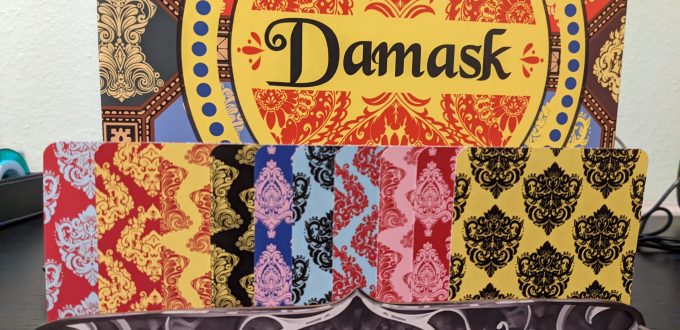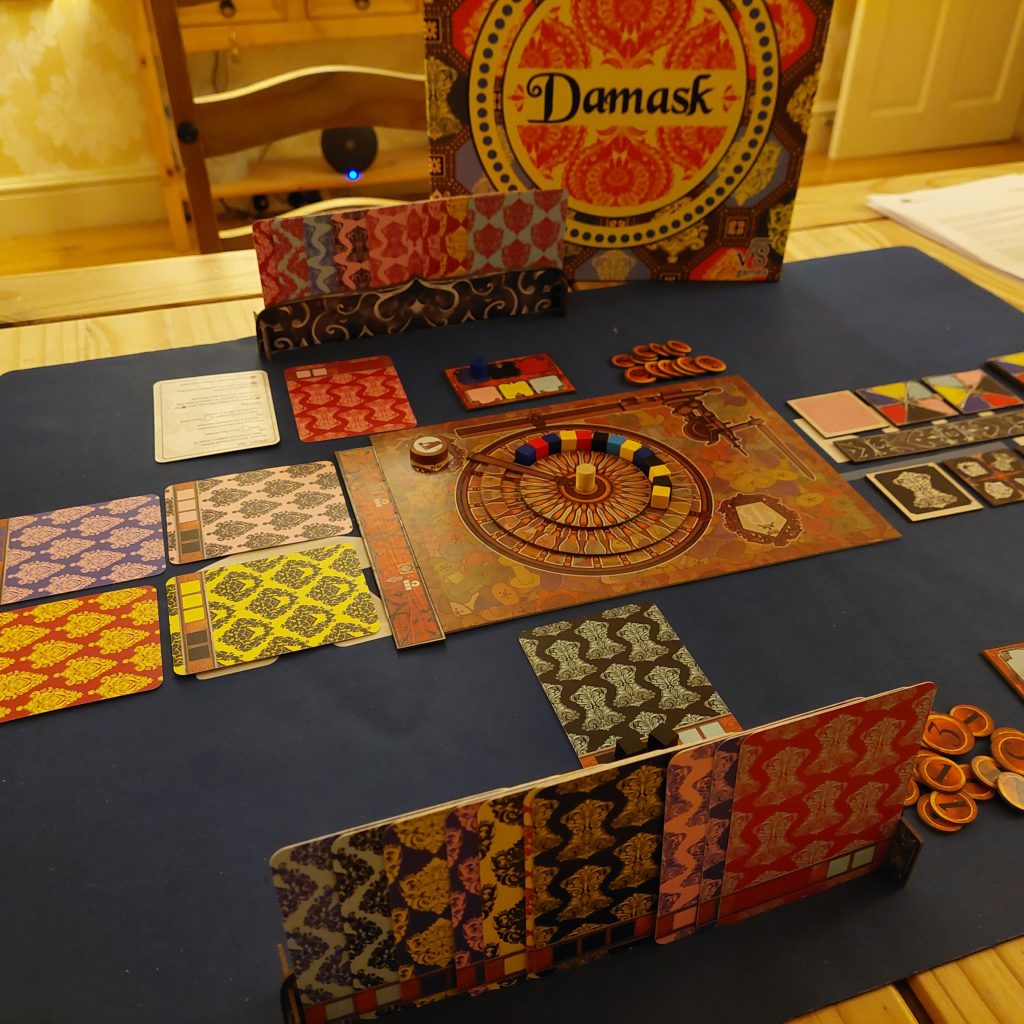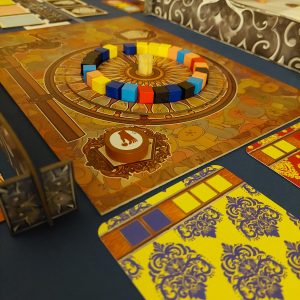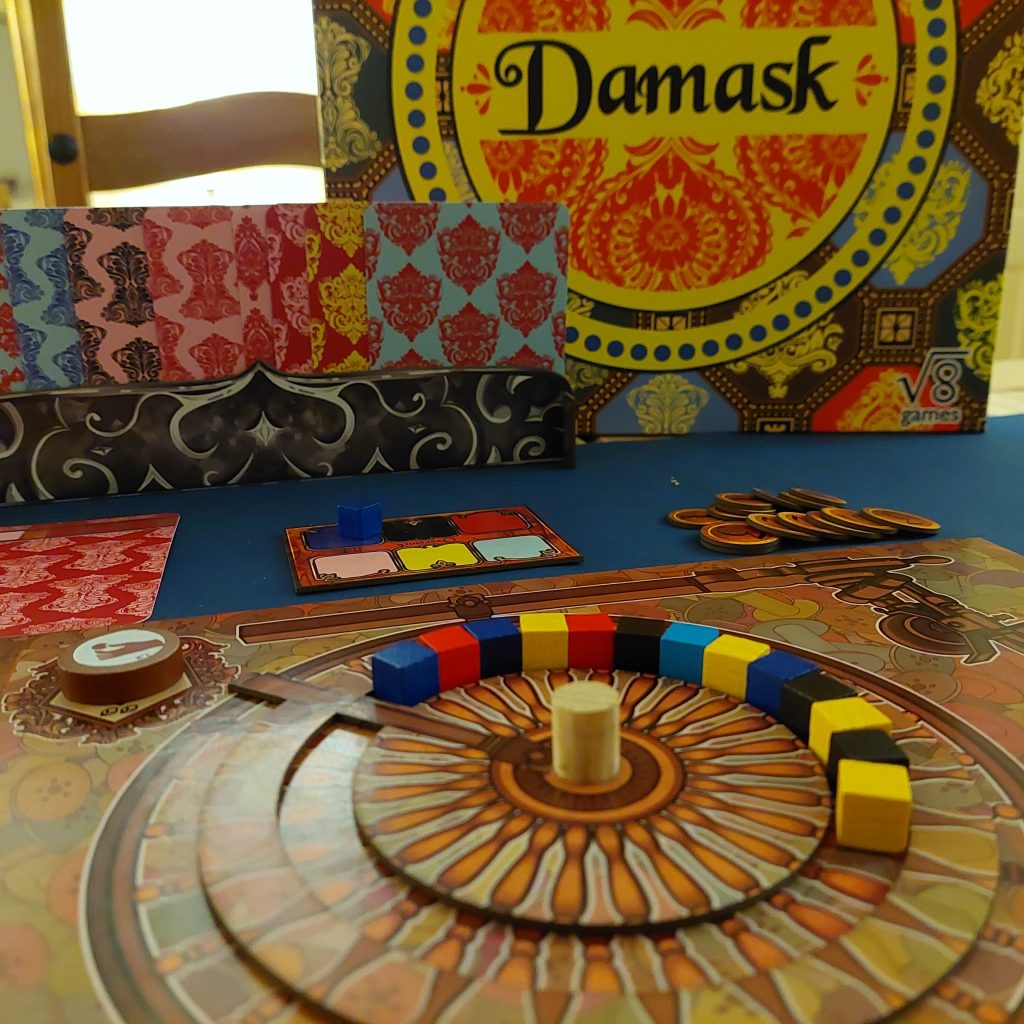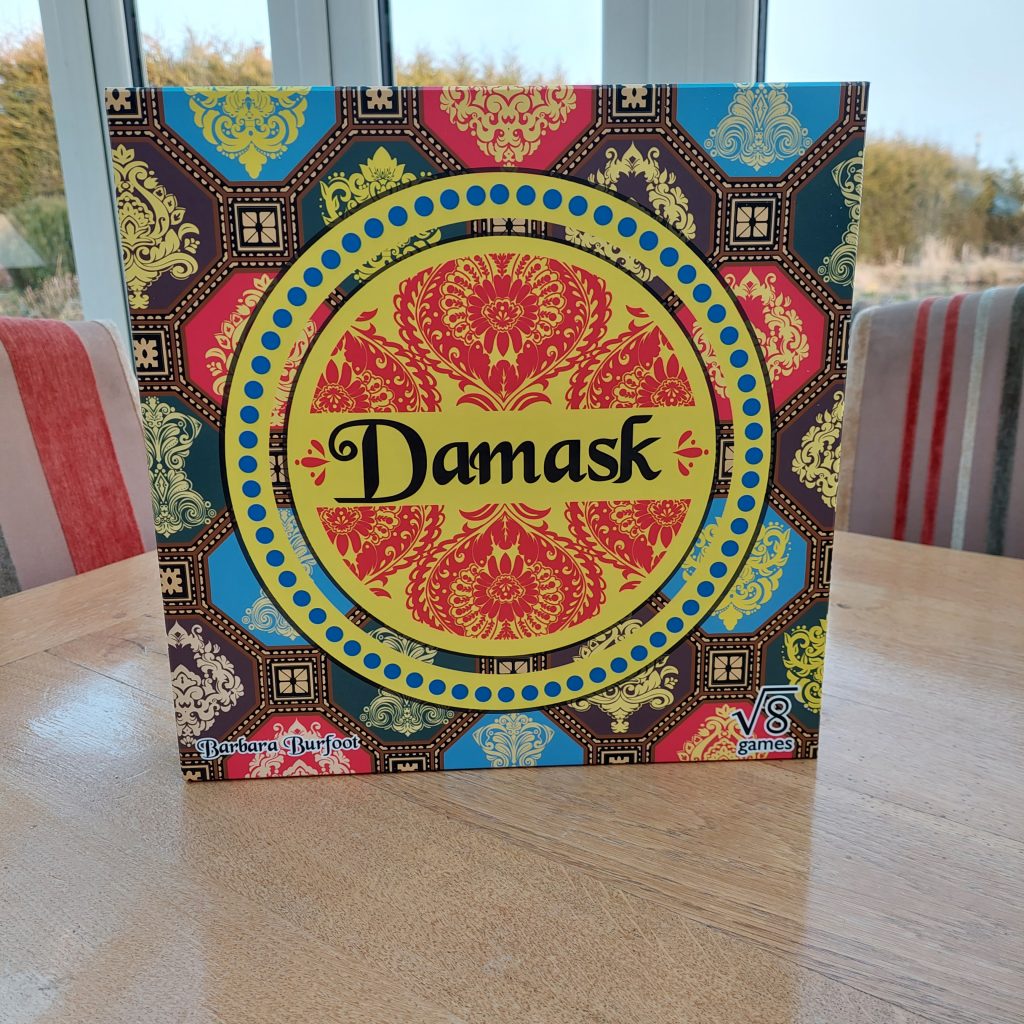Damask, the gorgeous game about spinning silks is hitting Gamefound on 27 April 2022. I went behind the box to find out more from its designer and publisher about the road to Damask!
Let’s start with you, Barbara, if we may. Thank you so much for chatting with me today, particularly as you have been very busy with a recent relocation to Canada – how exciting! Before we get into the beautiful world of damask and silk spinning, please can you tell us a little bit about yourself?
Nice to meet you Tora! Yes, I am back in Canada after a six-year stint in the UK. I’m a graphic designer and work remotely for my Canadian clients, so I am able to follow my husband around as he changes jobs. We both have British fathers, so we came to the UK for an adventure.
Before we came, I started to think about game design. I wanted to create more imaginative things that could be enjoyed by more people. I have two grown-up children, so I began with an idea for a game I wish had existed when they were young. It was the perfect time to move to the UK, as I was able to join the playtest groups, attend conventions, and work alongside other designers. I’ve learned so much, gained so many friends and colleagues. And just before heading back, Radical 8 Games offered to publish my first game!
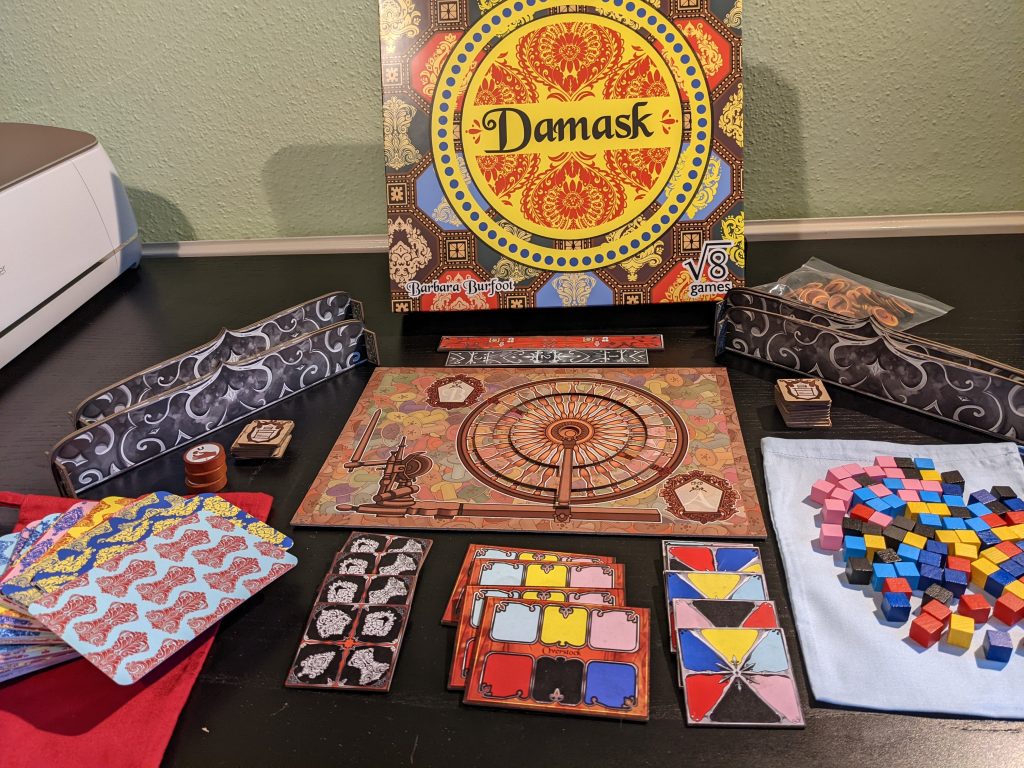
Goodness- what a brilliant end to your UK adventure! And from graphic design to game design – that’s such an interesting development! Apart from the art, of course, what parts of the process of game design are you enjoying the most?
It’s hard to say what I enjoy most…
Structuring a games system really appeals to my designer’s brain. All good visual or 3D design is built on a clearly defined underlying system, and board games are no different. I love building frameworks, balancing odds, and working out efficiencies. It was interesting to discover that many game designers I’ve met have a maths or engineering background. It makes so much sense.
The other aspect of game design that I love is world-building. As a child, I’d pore through books on Greek mythology and medieval fairy tales, and when I discovered a copy of the Lord of the Rings on a shelf in the far corner of the school library, it changed me forever.
Being able to combine these two elements — a formal system and a world or story — into one end product is pretty much all I could ask for. I can’t think of anything I’d rather do now.
I also have to mention that making prototypes is really fun. I use a lot of printer ink!
Ha ha well I have been very lucky to have played a prototype of Damask (full preview here), and I can attest to the high ink usage there! But I have really enjoyed diving into the Damask world you have created. In your own words, tell us what Damask is and what players will be doing when sitting at the table with that stunning looking box!
Damask is a lush puzzly game of patterns and colour. As a weaver of fine silk fabrics, you’ll be competing with others in the Guild to see who can create the most coordinated display, and earn the most wealth. You’ll fill your looms with silk thread, then mount them in your display, where you will gain coins for pattern and colour matches. You’ll have to manage your supplies well, as silk thread is in demand, and overstock costs. Fashion trends and favour with the Guild are key, so dress well when you sit down to play!
I didn’t know about the dress-code but I went away with patterns in my head! It has given our wallpaper at home a whole added layer of depth! Damask is definitely a game with beauty and brains – the strategic opportunities presented by the Guild Favours quickly becomes apparent after only just a few plays. You previously mentioned enjoying the process of working out efficiencies and connecting them to visuals in your designs. Do the mechanics of drafting and pattern matching factor into that?
I like that these mechanics, when combined, offer opportunities to make visual connections. As a graphic designer, I’m always thinking of the visual connections on a page, so I guess I’m drawn to these mechanics for the same reason. It just feels good to connect things that match and coordinate, and I wanted to give players a game where they could really indulge in that. There is also something calming and clean about enjoying shapes and colours simply for themselves, with no other meaning attached.
The other mechanic I like is set collection. I’m in that player profile that really enjoys collecting and completing sets of things. To complete a damask, you need a particular set of coloured cubes. As a designer, I wanted to give those set-collectors out there a game with lots of these satisfying little moments.

Well I am one of them and I thank you for it! Going back to the visual aspect for a moment, Damask is one of the most colourful games I have played. The patterns are beautifully intricate and the colours on the cards pop (and I have been told they will shine even brighter in the retail version). And colour matching through synergies in damask mounting is a main way to score coins and Guild Favours. As a graphic designer, did you consider colour vision deficiency issues and accessibility in your game design?
I’m a print designer, so in my work I have to pay attention to legibility and where colour is critical to understanding. However, I knew this would need to be handled carefully in this game.
The four patterns need to be easily distinguished in low light and when viewed from across the table, but they also need to maintain their intricate form. I used stock versions that worked for the playtests, but knew that final patterns would need to be created to meet both these needs.
The design also presented colour challenges. There are six colours, essential to gameplay, with no options for secondary coding. This would affect players with colour vision deficiencies, and everyone else under low lighting. The first way to address this was to make sure all colour combos were high contrast – either light on dark, or dark on light. For the actual colours, I tested various combos with a simulator and found a good working combination. It was not an option to use both red and green, so I opted for red as it felt more regal and rich! Mark understood all these important design considerations and has done a fantastic job of developing the final patterns and colours.
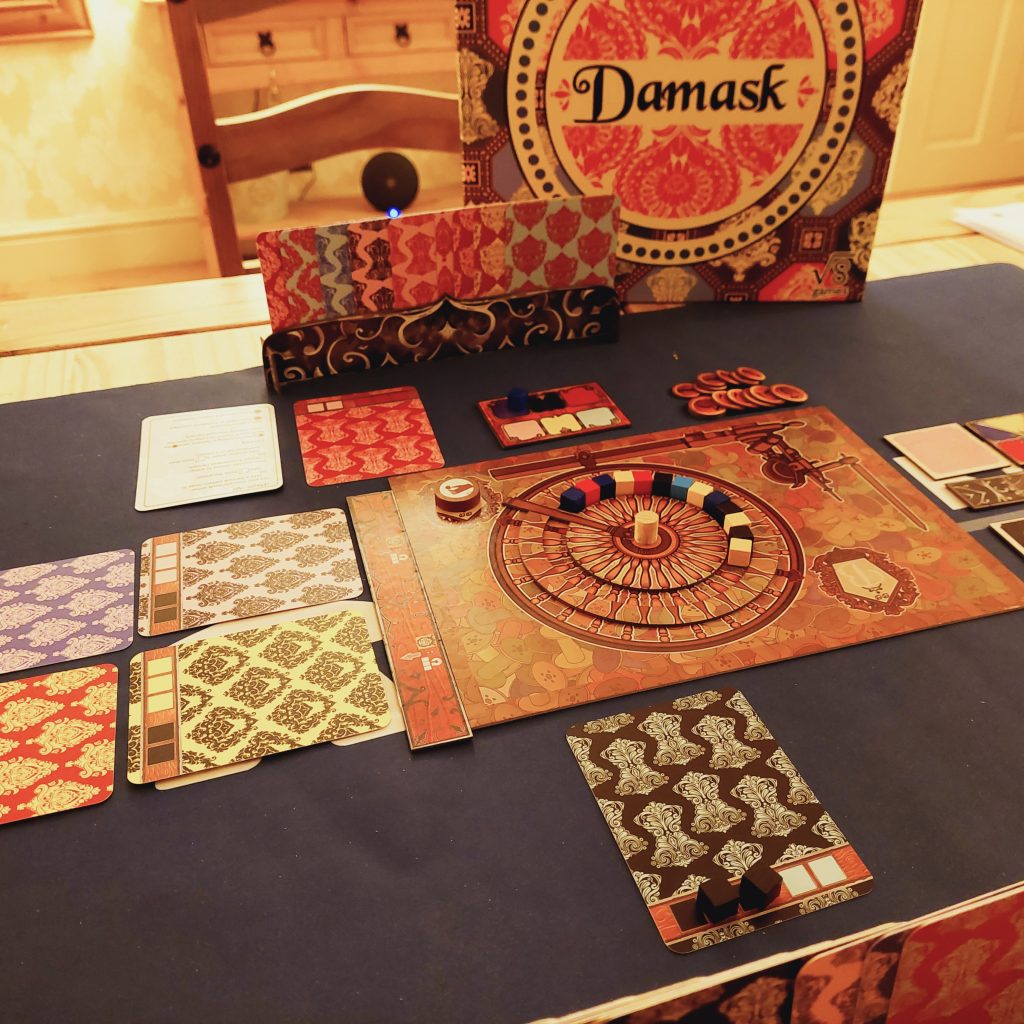
Everything about Damask is linked back to the setting. What came first in Damask: the theme or the interplay of mechanics/game play?
Theme led the way, but always with mechanics and gameplay in mind. I began with the end product focus, thinking about what would look beautiful on a table, be lovely to look at and handle, and also translate to an elegant system.
Damask fabrics quickly came to mind. They are gorgeous and have unlimited variety, yet they are built on a very simple system of one repeating pattern and two colours. This would translate naturally to a pattern and colour matching mechanic. I could see a table lavished with these designs, and imagine the pleasure of coordinating and arranging them.
I mocked up a series, balancing patterns and colours to arrive at a nicely sized deck. Then I thought about how to make it into a game. For a 3D component, it was obvious that the cards should be displayed in a rack. The story and mechanics then emerged from there: weavers add thread colours to looms to complete their damasks, and create a coordinated display. Fashion trends and influence with the guild would factor in.
Were you inspired by any particular designer or game when you were designing Damask?
Thematically, abstract strategy games that pull from historical arts and crafts were a primary inspiration (the stained glass of Sagrada, the tiles of Azul). I wanted to build a game around another classical artisanal element that hadn’t yet been used. For table presence, I’m a big fan of games with 3D centrepieces and components that are cleverly constructed of cardboard. I wanted to incorporate something that lifts off the table.
And what a beautiful idea that was! Every game takes a different journey from idea to table. Although Mark at Radical 8 has kindly shared a design diary on BoardGameGeek, please can you tell us a little bit more about your own experiences on the road to Damask!
The idea came to me while leaving Spiel in 2019. Up until then, my focus was on kids’ games. Inspired by the amazing game art I’d seen, I challenged myself to design a grown-up game with strong table presence. On the train home, I began to work out colour and pattern combos in the notes on my phone.
First iterations were tested on my husband, which was great, as he doesn’t really play board games. If it could get him to play more than once, I felt I was on to something!
Before lockdown started, I was able to test and refine with designers at Playtest UK, London Waterloo and Reading groups. Lockdown then started, so I sent it out for some blind playtests throughout 2020. Then happily, the UKGE was back on and I was able to attend the Publisher-Designer Speed Dating. That was where Mark saw the game. A couple of weeks later, he contacted me!
The original concept I had was pretty close to the one I landed on. The primary shift I made was in the elements you draft. My first idea was to draft both a pattern tile and colour cubes to complete a damask. The proved to be a too complex a puzzle, and simplifying to just drafting colours was the way to go. It’s been wonderful to see the game evolve even more, once Mark took the helm, including the addition of the clever spinning wheel and solo mode.
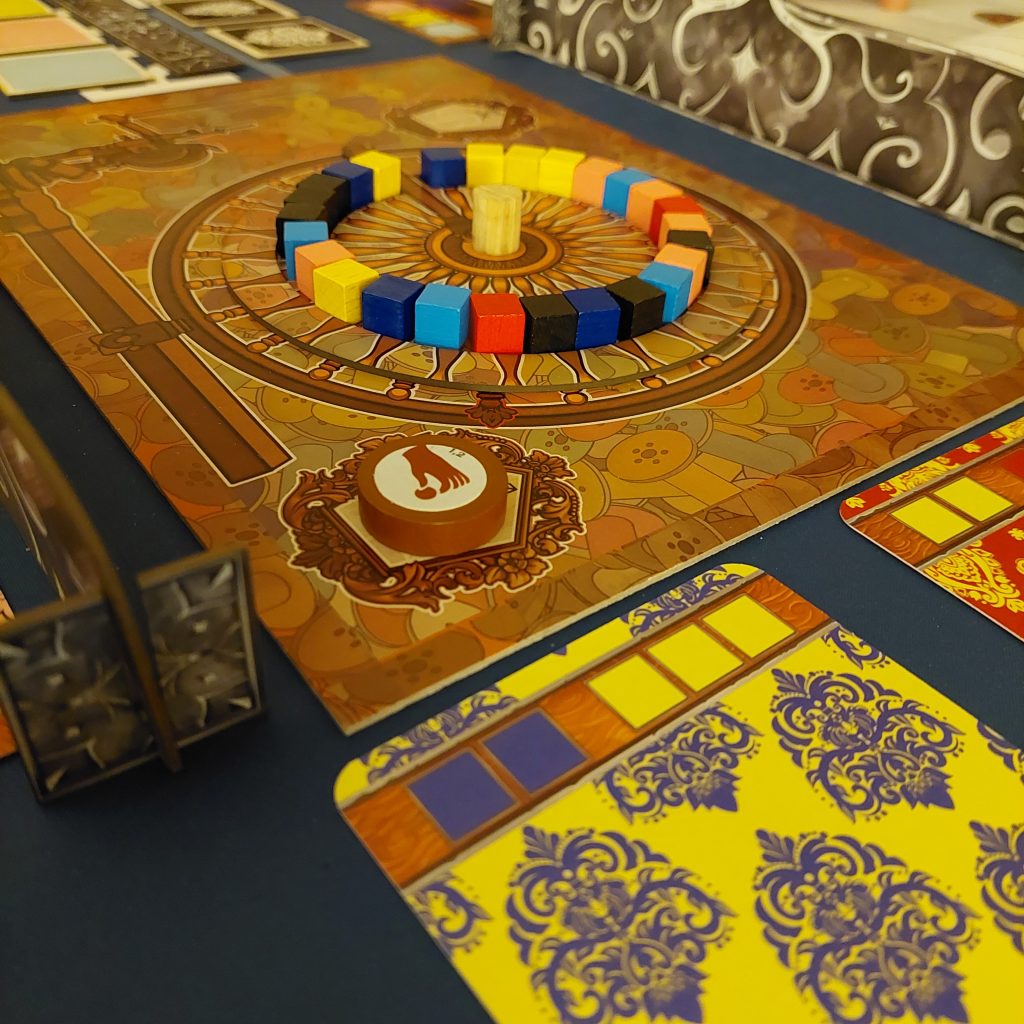
Ah so children’s games are in your design remit too! Are there any in the running at the moment? Care to share some sneaky clues?
I have a few ideas for board games for kids on the go, but there is one that I’m considering self-publishing. It is a collectible-style card game with rich fantasy illustrations you find on Magic cards, but with themes for kids. I’m learning how to illustrate the artwork myself, so this is a massive, but hugely enjoyable endeavour. I took a break from this project to work up Damask – the first game I’ve designed that hasn’t involved fairies, forests, or dragons!
Well, with a dragon mad husband and a game obsessed almost 7 year old, I predict that Damask will not be the last Barbara Burfoot design on our gaming shelf! Now, I realise that I have taken up far too much of your time already, but I am going to sneak one last question just for fun, if I may? If you could play a board game with anybody (real or fictional), who would it be, what game would you play, and (perhaps most important of all!) what snacks would you choose? ?
This is your most difficult question, Tora!! There are so many brilliant games I’d love to play with my many heroes… So I guess I’ll go back to my childhood influences and inspirations, where this whole journey of mine began. I’d play a quiet, contemplative game of chess with Gandalf.
Although we wouldn’t talk much, as I made my moves, I’d be watching his face for subtle expressions of warning, questioning, or approval. I’m sure I’d also pick up some life lessons along the way. I’m not sure if wizards actually need to eat much, but just in case, I’d serve honey mead and mushroom pate on rustic bread. There would also be many forms of dark chocolate.
Gosh, what a feast for the mind and tummy that would be! Barbara, thank you once again so much for chatting with me today. It has been an absolute privilege to find out more about your background, inspiration, and future projects. I am very much looking forward to a gaming future (and shelves!) filled with games by Barbara Burfoot and Radical 8 Games!
Now, I realise that Barbara has raised the bar very high, Mark, but I think you’ll rise to the challenge!
Mark, you have chosen to launch Damask on Gamefound rather than Kickstarter. As a backer, I have used both. What made you decide to use Gamefound as a publisher over other crowd funding platforms?
Two things- EU VAT and blockchain nonsense. There’s been loads written by people more knowledgeable than myself about blockchain, but I just don’t like the way it seems to be forced upon people by every online company. As such, it’s nice to switch to something which doesn’t use it. Secondly, EU VAT is a big issue at the moment, and companies have to jump through multiple hoops to pay it when selling online through Kickstarter. But it’s an area that Gamefound take care of for creators.
How have you found the preparation for the campaign launch on 27 April?
Better than during lockdown! It has been nice to be able to get the game in front of people easily, for playtesting and then demoing. Of course, it’s impossible to say how the campaign prep has really gone before the campaign begins, as funding will be the marker, so we’ll just have to cross our fingers!

You mentioned playtesting – how was the experience of playtesting Damask?
Incredibly smooth. Barbara had designed a solid base game, and it was a really good bedrock from which to develop. I was also lucky that we started playtesting around the same time lockdown ended, which meant there was a taste for playing games- it felt like I had people playtesting it daily.
You also mentioned demoing Damask – How did you find Airecon?
Fantastic! I love Airecon, even more so than the UKGE, and not just because it’s local! Demoing there is always a great experience, and this time was no exception- just fantastic feedback all weekend long. Of course, an unexpected bonus when we popped up in the ‘Watch it Played’ Top 10 On The Radar, which blew us away.
Wowza! Hitting the hotness before the campaign has even launched! For those who haven’t seen your fascinating design diary on BGG, you came up with the idea for the spinning wheel and the solo mode – how did those ideas come about?
The spinning wheel was a thematic solution to a problem about how to make the cube choices more interesting. It was a case of firing off ideas and then testing them to see which worked, and this one did. The thematic connection is obvious, but the ability to turn it into a really thoughtful choice easily put it over the top.
The solo mode came from requests on Die of the Dead for a solo mode. I’ve played a couple of solo games, and I know that for me a solo game is a puzzle. It’s why I didn’t do one for Die of the Dead- in that game, the mechanic is competitive dice rolling, so if you remove the competitiveness, there’s not much of a puzzle. But in Damask, the spinning wheel and cube selection made this much more of a puzzle friendly possibility. And so developing the solo mode led easily from that- how can we make the players puzzle over what to do, without there being an obvious solution? It turns out the game already has a perfect blend of knowns and unknows to make this a natural fit.
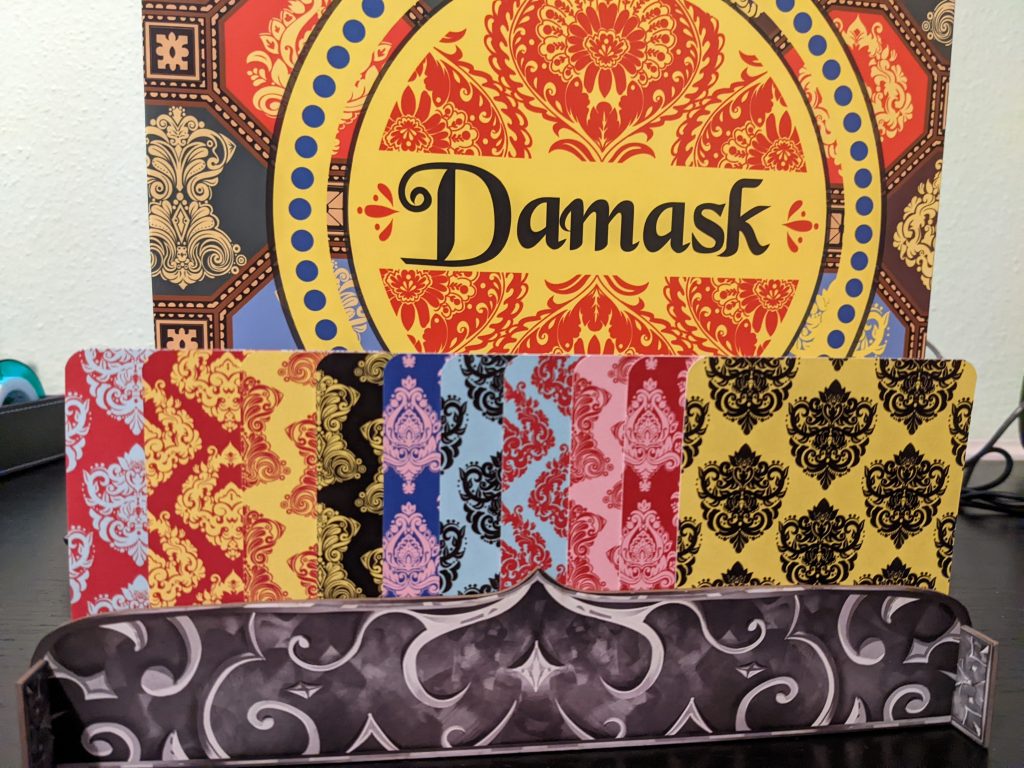
Well I am an avid solo gamer and I so was very happy to see single player mode in Damask! On the basis that it funds, what is the timeline once the campaign ends?
As soon as we fund we are in talks with the factory to produce a sample copy, so by the time we’ve got the final numbers we can immediately begin production. We do like to build in time for any delays which might arise, so we’re looking at manufacturing in June-July, then shipping in August-October, to be delivered to people’s homes around November.
Just in time for cold winter nights drawing in and the perfect excuse to stay inside and play the beautiful Damask!
Many thanks Mark – your insight into the campaign has been really interesting and I wish you the best of luck as I really want to see Damask on tables everywhere (including my own!) by the end of the year!!
If you think Damask could be a game for you, keep an eye on Radical 8 Games here (Facebook) or here (Twitter), and of course on Gamefound for an announcement soon!

